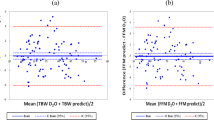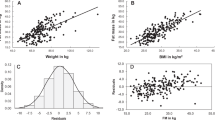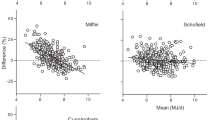Abstract
Objective:
There are considerable differences in published prediction algorithms for resting energy expenditure (REE) based on fat-free mass (FFM). The aim of the study was to investigate the influence of the methodology of body composition analysis on the prediction of REE from FFM.
Design:
In a cross-sectional design measurements of REE and body composition were performed.
Subjects:
The study population consisted of 50 men (age 37.1±15.1 years, body mass index (BMI) 25.9±4.1 kg/m2) and 54 women (age 35.3±15.4 years, BMI 25.5±4.4 kg/m2).
Interventions:
REE was measured by indirect calorimetry and predicted by either FFM or body weight. Measurement of FFM was performed by methods based on a 2-compartment (2C)-model: skinfold (SF)-measurement, bioelectrical impedance analysis (BIA), Dual X-ray absorptiometry (DXA), air displacement plethysmography (ADP) and deuterium oxide dilution (D2O). A 4-compartment (4C)-model was used as a reference.
Results:
When compared with the 4C-model, REE prediction from FFM obtained from the 2C methods were not significantly different. Intercepts of the regression equations of REE prediction by FFM differed from 1231 (FFMADP) to 1645 kJ/24 h (FFMSF) and the slopes ranged between 100.3 kJ (FFMSF) and 108.1 kJ/FFM (kg) (FFMADP). In a normal range of FFM, REE predicted from FFM by different methods showed only small differences. The variance in REE explained by FFM varied from 69% (FFMBIA) to 75% (FFMDXA) and was only 46% for body weight.
Conclusion:
Differences in slopes and intercepts of the regression lines between REE and FFM depended on the methods used for body composition analysis. However, the differences in prediction of REE are small and do not explain the large differences in the results obtained from published FFM-based REE prediction equations and therefore imply a population- and/or investigator specificity of algorithms for REE prediction.
This is a preview of subscription content, access via your institution
Access options
Subscribe to this journal
Receive 12 print issues and online access
$259.00 per year
only $21.58 per issue
Buy this article
- Purchase on Springer Link
- Instant access to full article PDF
Prices may be subject to local taxes which are calculated during checkout
Similar content being viewed by others
References
Bader N, Bosy-Westphal A, Dilba B, Müller MJ (2005). Intra- and interindividual variability of resting energy expenditure (REE) in healthy male subjects – biological and methodological variability of REE. Br J Nutr 94, 843–849.
Bland JM, Altman DG (1986). Statistical methods for assessing agreement between two methods of clinical measurement. Lancet 1, 301–310.
Bosy-Westphal A, Danielzik S, Becker C, Geisler C, Onur S, Korth O et al. (2005). Need for optimal body composition data analysis using air-displacement plethysmography in children and adolescents. J Nutr 135, 2257–2262.
Brozek J, Grande F, Anderson JT, Keys A (1963). Densitometric analysis of body composition: revision of some quantitative assumptions. Ann N Y Acad Sci 110, 113–140.
Cole TJ, Henry CJK (2002). The Oxford Brookes Basal Metabolic Rate Database – A Reanalysis. Report commissioned by FAO for the Joint FAO/WHO/UNU Expert Consultation on Energy in human nutrition. FAO: Rome.
Cole TJ, Henry CJK (2005). The Oxford Brookes basal metabolic rate database – a reanalysis. Public Health Nutr 8, 1202–1212.
Cunningham JJ (1991). Body composition as a determinant of energy expenditure: a synthetic review and a proposed general prediction equation. Am J Clin Nutr 54, 963–969.
Dempster P, Aitkens S (1995). A new air displacement method for the determination of human body composition. Med Sci Sports Exerc 27, 1692–1697.
Durnin JV, Womersley J (1974). Body fat assessed from body density and its estimation from skinfold thickness measurements on 481 men and women aged from 16 to 72 years. Br J Nutr 32, 77–97.
Elia M (1992). Energy expenditure in the whole body. In: Kinney JM, Tucker HN (eds). Energy Metabolism: Tissue Determinants and Cellular Corollaries. Raven press: New York. pp 19–59.
Ellis KJ (2001). Selected body composition methods can be used in field studies. J Nutr 131, 1589S–1595S.
Frankenfield D, Roth-Yousey L, Compher C (2005). Comparison of predictive equations for resting metabolic rate in healthy nonobese and obese adults: a systematic review. J Am Diet Assoc 105, 775–789.
Fuller NJ, Jebb SA, Laskey MA, Coward WA, Elia M (1992). Four-component model for the assessment of body composition in humans: comparison with alternative methods, and evaluation of the density and hydration of fat-free mass. Clin Sci 82, 687–693.
Henry CJK (2002). Basal Metabolic Rate Studies in Humans: Measurement and Development of New Equations. Background document prepared for the Joint FAO/WHO/UNU Expert Consultation on energy in human nutrition. FAO: Rome.
Jennings G, Bluck L, Wright A, Elia M (1999). The use of infrared spectrophotometry for measuring body water spaces. Clin Chem 45, 1077–1081.
Jensen MD, Braun JS, Vetter RJ, Marsh HM (1988). Measurement of body potassium with a whole-body counter: relationship between lean body mass and resting energy expenditure. Mayo Clin Proc 63, 864–868.
Kushner RF, Schoeller DA (1986). Estimation of total body water by bioelectrical impedance analysis. Am J Clin Nutr 44, 417–424.
LaForgia J, van der Ploeg GE, Withers RT, Gunn SM, Brooks AG, Chatterton BE (2004). Impact of indexing resting metabolic rate against fat-free mass determined by different body composition models. Eur J Clin Nutr 58, 1132–1141.
Laskey MA (1996). Dual-energy X-ray absorptiometry and body composition. Nutrition 12, 45–51.
Lohman TG, Roche AF, Martorell R (1988). Anthropometric Standardization Reference Manual. Human Kinetics Publishers: Champaign, IL.
Mifflin MD, St Jeor ST, Hill LA, Scott BJ, Daugherty SA, Koh YO (1990). A new predictive equation for resting energy expenditure in healthy individuals. Am J Clin Nutr 51, 241–247.
Müller MJ, Bosy-Westphal A, Klaus S, Kreymann G, Luhrmann PM, Neuhauser-Berthold M et al. (2004). World Health Organization equations have shortcomings for predicting resting energy expenditure in persons from a modern, affluent population: generation of a new reference standard from a retrospective analysis of a German database of resting energy expenditure. Am J Clin Nutr 80, 1379–1390.
Owen OE (1988). Resting metabolic requirements of men and women. Mayo Clin Proc 63, 503–510.
Ramirez-Zea M (2005). Validation of three predictive equations for basal metabolic rate in adults. Public Health Nutr 8, 1213–1228.
Ravussin E, Bogardus C (1989). Relationship of genetics, age, and physical fitness to daily energy expenditure and fuel utilization. Am J Clin Nutr 49 (5 Suppl), 968–975.
Ravussin E, Burnand B, Schutz Y, Jequier E (1982). Twenty-four-hour energy expenditure and resting metabolic rate in obese, moderately obese, and control subjects. Am J Clin Nutr 35, 566–573.
Ravussin E, Lillioja S, Anderson TE, Christin L, Bogardus C (1986). Determinants of 24-hour energy expenditure in man. Methods and results using a respiratory chamber. J Clin Invest 78, 1568–1578.
Reeves MM, Davies PS, Bauer J, Battistutta D (2004). Reducing the time period of steady state does not affect the accuracy of energy expenditure measurements by indirect calorimetry. J Appl Physiol 97, 130–134.
Schoeller DA (1996). Hydrometry. In: Roche AF, Heymsfield SB, Lohman TG (eds). Human Body Composition. Human Kinetics: Campaign, IL, USA. pp 25–43.
Schofield C (1985). An annotated bibliography of source material for basal metabolic rate data. Hum Nutr: Clin Nutr 39 (Suppl 1), 42–91.
Siri WE (1961). Body composition from fluid spaces and density: analysis of method. In: Brozek J, Henschel A (eds). Techniques For Measuring Body Composition. National Academy of Sciences: Washington, DC. pp 223–244.
van der Ploeg GE, Withers RT (2002). Predicting the resting metabolic rate of 30–60-year-old Australian males. Eur J Clin Nutr 56, 701–708.
Wang Z, Heshka S, Wang J, Wielopolski L, Heymsfield SB (2003). Magnitude and variation of fat-free mass density: a cellular-level body composition modeling study. Am J Physiol Endocrinol Metab 284, E267–273.
Weir JB (1949). New methods for calculating metabolic rate with special reference to protein metabolism. J Physiol 109, 1–9.
Withers RT, LaForgia J, Heymsfield SB (1999). Critical appraisal of the estimation of body composition via two-, three-, and four-compartment models. Am J Hum Biol 11, 175–185.
Author information
Authors and Affiliations
Corresponding author
Additional information
Guarantor: MJ Müller.
Contributors: MJM contributed to study design, OK, ABW and PZ contributed to data collection, OK and ABW contributed to data analysis, OK, ABW, MJM, CCG and MH contributed to discussion of data, and OK, ABW and MJM writing of the paper. There are no conflicts of interest.
Rights and permissions
About this article
Cite this article
Korth, O., Bosy-Westphal, A., Zschoche, P. et al. Influence of methods used in body composition analysis on the prediction of resting energy expenditure. Eur J Clin Nutr 61, 582–589 (2007). https://doi.org/10.1038/sj.ejcn.1602556
Received:
Revised:
Accepted:
Published:
Issue Date:
DOI: https://doi.org/10.1038/sj.ejcn.1602556
Keywords
This article is cited by
-
The combined association of dietary inflammatory index and resting metabolic rate on cardiorespiratory fitness in adults
Journal of Health, Population and Nutrition (2023)
-
An evaluation of basal metabolic rate among healthy individuals — a cross-sectional study
Bulletin of Faculty of Physical Therapy (2023)
-
Accuracy of Resting Metabolic Rate Prediction Equations in Athletes: A Systematic Review with Meta-analysis
Sports Medicine (2023)
-
Review on modelling approaches of thermoregulation mechanisms
Journal of Thermal Analysis and Calorimetry (2023)
-
Predicting resting energy expenditure in people with chronic spinal cord injury
Spinal Cord (2022)



